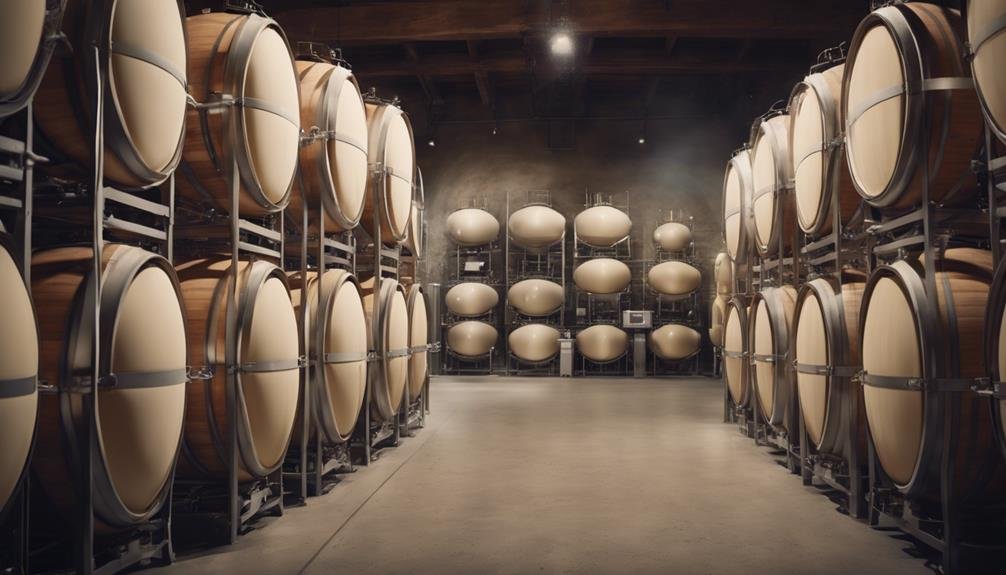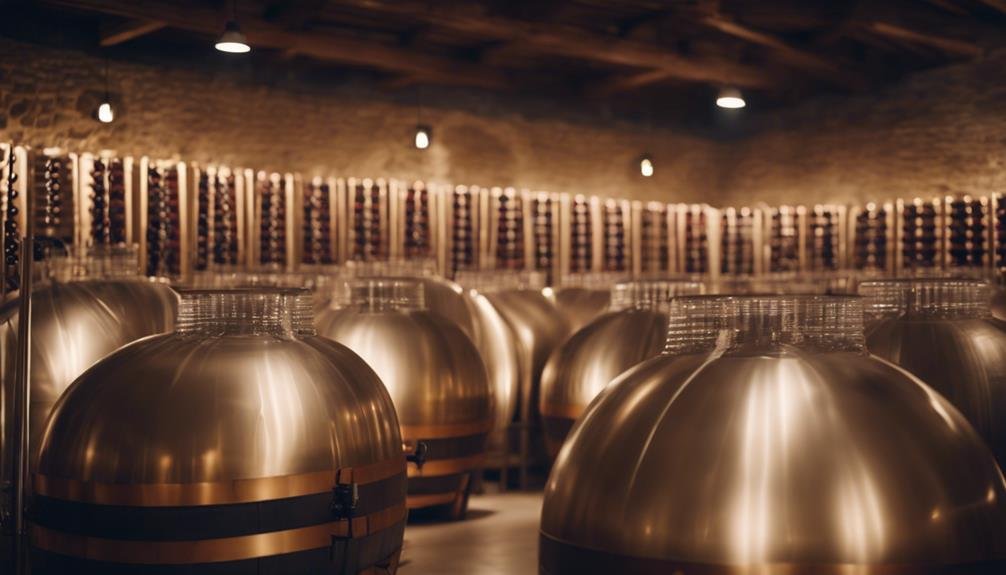Egg-shaped fermenters are more than a passing trend; they are a wine revolution. With a historical legacy dating back over 8,000 years, these vessels, combining ancient practices with modern techniques, profoundly impact wine fermentation and flavor development. Concrete egg fermenters enhance wine texture and flavor by offering controlled aeration and retaining lees in suspension. Innovative features like vortex currents and natural convection further elevate the process. Compared to traditional methods, egg-shaped fermenters excel in gentle aeration and developing wine texture, providing winemakers with diverse tools to craft unique and flavorful wines. Embracing these vessels may reveal new dimensions in winemaking excellence.
Historical Significance of Egg-Shaped Fermenters
With a history spanning over 8,000 years, the use of egg-shaped fermenters, such as the traditional qvevri in Georgia, holds significant historical importance in winemaking practices. These vessels, with their Georgian origins, were essential for fermenting and aging wine.
The influence of Roman winemaking practices, seen in similar oblong vessels like amphorae, also contributed to the use of egg-shaped fermenters. While the Romans shifted to oak barrels, the modern resurgence of these fermenters began in 2001.
This historical background highlights the enduring appeal and relevance of egg-shaped fermenters in winemaking, blending ancient traditions with contemporary techniques for producing exceptional wines.
Advantages of Concrete Egg Fermenters
Concrete egg fermenters offer distinct advantages in the winemaking process due to their unique shape and material properties. The use of materials like concrete and ceramic in these fermenters allows for controlled aeration, which aids in the aging of wine.
This controlled exposure to oxygen helps enhance the texture of the wine, resulting in a more refined and complex flavor profile. Additionally, the shape of the egg fermenters helps retain lees in suspension, contributing to the enhanced texture of the wine.
Winemakers have found that wines aged in concrete egg fermenters develop their flavors faster compared to those aged in stainless steel, making these fermenters a valuable tool in the winemaking process.
Innovative Features in Egg Fermentation

The innovative features of egg-shaped fermenters in winemaking highlight their unique design elements that contribute to the fermentation process and the development of wine characteristics. These fermenters offer advantages such as promoting vortex currents and providing aeration benefits, which aid in enhancing the wine aging process. The shape of the fermenter allows for natural convection currents, ensuring a more uniform distribution of heat during fermentation. Additionally, controlled exposure to oxygen in egg fermenters aids in gradual wine aging, resulting in a smoother and more developed flavor profile. Winemakers can leverage these features to experiment and influence the texture and mouthfeel of wines, offering a distinct approach compared to traditional fermentation methods.
| Features | Benefits |
|---|---|
| Vortex currents | Promote uniform heat distribution |
| Aeration benefits | Enhance wine aging process |
Egg-Shaped Vs. Traditional Methods Comparison
Egg-shaped fermenters offer winemakers a unique alternative to traditional methods, allowing for distinct influences on wine structure and flavor profiles.
The benefits of egg-shaped fermenters include promoting a natural current within the vessel, controlled aeration aiding in wine aging, and enhancing texture and flavor by retaining lees in suspension.
In contrast, traditional techniques like oak barrels and stainless steel tanks provide different options for winemakers to influence the final wine profile.
Egg fermenters excel in gentle aeration, which enhances wine flavor and softens tannins, while the vortex current helps develop wine texture.
This choice between different vessels offers a balance between controlled oxygen exposure and wine aging, providing winemakers with diverse tools to craft unique and flavorful wines.
Future Trends in Wine Fermentation

In the ever-evolving landscape of winemaking, emerging trends in fermentation techniques are shaping the future of the industry.
Future Trends in Wine Fermentation:
- Sustainable Practices: Winemakers are increasingly embracing eco-friendly methods to reduce their environmental impact. Implementing sustainable practices in fermentation can lead to more environmentally conscious production processes.
- Technological Advancements: The integration of cutting-edge technologies in fermentation processes is revolutionizing the way wines are crafted. From advanced temperature control systems to automated fermentation monitoring, technology is enhancing efficiency and quality in winemaking.
- Innovative Materials: The exploration of new materials for fermentation vessels, such as bio-degradable polymers or recycled resources, is on the rise. Innovations in materials aim to improve fermentation processes while aligning with sustainability goals in the wine industry.
Frequently Asked Questions
How Do Winemakers Clean and Maintain Egg-Shaped Fermenters?
To guarantee peak performance, winemakers clean egg-shaped fermenters by utilizing specialized cleaning procedures involving mild detergents and non-abrasive tools. A thorough maintenance schedule, including regular inspections for residue buildup, helps uphold hygiene standards and preserve wine quality.
Are There Specific Grape Varieties That Benefit Most From Egg Fermentation?
Certain grape varieties, like Chardonnay, flourish in egg-shaped fermenters, benefiting from enhanced texture and flavor development. Conversely, Pinot Noir may not see the same advantages. Sauvignon Blanc thrives, while Merlot might not reach its full potential.
Can Egg-Shaped Fermenters Be Used for Other Types of Beverages?
Egg-shaped fermenters can be utilized for various beverages beyond wine, including coffee brewing and beer production. The unique design and controlled aeration of these vessels offer opportunities for experimentation and flavor development in different types of fermentation processes.
What Is the Environmental Impact of Using Concrete Egg Fermenters?
Concrete egg fermenters offer environmental sustainability through energy-efficient production, with concrete being a durable material compared to traditional vessels. The efficient temperature control and natural convection currents contribute to production efficiency, aligning with eco-conscious winemaking practices.
Do Egg-Shaped Fermenters Require Specialized Training for Winemakers?
Specialized training is essential for winemakers using egg-shaped fermenters due to unique care requirements. Understanding equipment care, winemaking techniques, and production efficiency is vital for harnessing the full potential of these vessels.
Conclusion
To sum up, the use of egg-shaped fermenters in winemaking has a rich historical significance dating back thousands of years. With their advantages in texture, flavor development, and aging processes, these innovative vessels offer a unique approach to fermentation.
While they may represent a revolution in modern winemaking practices, the future role of egg-shaped fermenters remains a topic of ongoing discussion and exploration within the industry. Their impact on wine profiles continues to be a subject of interest and debate among winemakers.